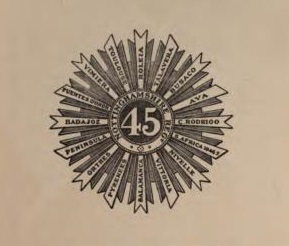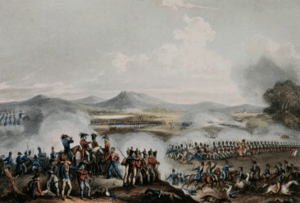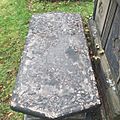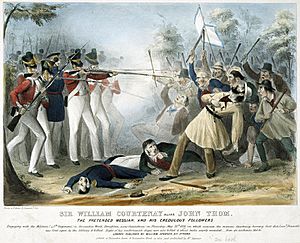45th (Nottinghamshire) (Sherwood Foresters) Regiment of Foot facts for kids
Quick facts for kids 45th (Nottinghamshire) (Sherwood Foresters) Regiment of Foot |
|
|---|---|

Badge of the 45th Regiment of Foot
|
|
| Active | 1741–1881 |
| Country | |
| Branch | |
| Type | Line Infantry |
| Role | Infantry |
| Size | One battalion (two battalions 1804–1814) |
| Garrison/HQ | Glen Parva Barracks, Leicestershire |
| Nickname(s) | "Old Stubborns" |
| Engagements | Father Le Loutre's War French and Indian War American Revolutionary War Peninsular War First Anglo-Burmese War Xhosa Wars |
The 45th (Nottinghamshire) (Sherwood Foresters) Regiment of Foot was a famous British Army group of soldiers. They were a "line infantry" regiment, which means they fought in lines on battlefields. This regiment was started in 1741.
They fought in many important wars. These included the French and Indian War and the American Revolutionary War. They also fought in the Peninsular War in Europe. In 1881, this regiment joined with another one. They became part of the Sherwood Foresters (Nottinghamshire and Derbyshire Regiment).
Contents
The Early Years of the Regiment (1741-1778)
How the Regiment Started
The 45th Regiment began in 1741. It was first called "Houghton's Regiment" after its leader, Colonel Daniel Houghton. They were formed to fight in the War of the Austrian Succession.
In 1745, they went to Gibraltar. Then, in 1747, they moved to Nova Scotia in North America. Here, they were led by Colonel Hugh Warburton. At first, they were known as the 56th Regiment. But in 1748, their number changed to the 45th Regiment of Foot. From 1751, regiments were known by their number, not by their commander's name.
Fighting in North America
The 45th Regiment fought in important battles in North America. In June 1755, they helped defeat French soldiers and their allies. This happened at the Battle of Fort Beauséjour.
They also took part in the Siege of Louisbourg in July 1758. This was during the French and Indian War.
Later, the regiment fought in the American War of Independence. They were at the Battle of Long Island in August 1776. They returned to England in 1778.
Becoming the Nottinghamshire Regiment
In 1779, people from Nottinghamshire asked for their county's name to be part of the regiment's name. This was allowed. The regiment became the 45th (1st Nottinghamshire) Regiment.
In 1786, they sailed to the West Indies. They were stationed on islands like Martinique and Dominica. They served there during the French Revolutionary Wars.
Famous Soldiers of the 45th Regiment
Some notable people served in the 45th Regiment:
Pictures from the Early Years
Fighting in the Napoleonic Wars (1807-1814)
Battles in South America
In 1807, the regiment went on a difficult mission. They were part of the British invasions of the River Plate in South America. They fought at the Second Battle of Buenos Aires in July 1807. Some soldiers went missing, but another part of the regiment fought bravely. They captured enemy cannons and prisoners.
The Peninsular War in Europe

In July 1808, the regiment sailed to Portugal. They joined General Sir Arthur Wellesley (who later became Duke of Wellington). This was for the Peninsular War against Napoleon's French army.
They fought in many battles:
- Battle of Roliça (August 1808)
- Battle of Vimeiro (August 1808)
- Battle of Talavera (July 1809) – Here, they earned their famous nickname, "Old Stubborns," for their bravery.
- Battle of Bussaco (September 1810)
- Battle of Fuentes de Oñoro (May 1811)
- Siege of Ciudad Rodrigo (January 1812)
- Siege of Badajoz (March 1812)
- Battle of Salamanca (July 1812)
- Battle of Vitoria (June 1813)
After these battles, they chased the French army into France. They fought at the Battle of the Pyrenees (July 1813), Battle of Nivelle (November 1813), Battle of Orthez (February 1814), and the Battle of Toulouse (April 1814). The regiment returned home in June 1814.
Service in Asia
In January 1819, the regiment was sent to Ceylon. Then, in 1824, they went to Burma. They fought in the First Anglo-Burmese War. They were part of an army that moved up the Irrawaddy River. They returned to England in March 1838.
The Victorian Era (1838-1881)
Events in England
In May 1838, the regiment was involved in the Battle of Bossenden Wood. This was a small fight in Kent, England. Soldiers from the 45th Regiment were sent to arrest a man named John Nichols Tom. He called himself "Sir William Courtenay" and had gathered followers.
In November 1839, the regiment helped stop the Newport Rising. This was a protest organized by a group called the Chartists.
Service in South Africa
The regiment went to South Africa in 1843. They fought in the Seventh Xhosa War in 1846. They also fought in the Eighth Xhosa War in 1851. They returned home in 1859.
In 1866, the regiment's name changed again. It became the 45th (Nottinghamshire) (Sherwood Foresters) Regiment of Foot. They also took part in the British Expedition to Abyssinia in 1867.
The End of the Regiment
In the 1870s, there were changes in the British Army. These were called the Cardwell Reforms. The 45th Regiment was linked with the 17th (Leicestershire) Regiment of Foot. They shared a base at Glen Parva Barracks.
On July 1, 1881, bigger changes happened. These were the Childers Reforms. The 45th Regiment joined with the 95th (Derbyshire) Regiment. Together, they formed a new regiment called the Sherwood Foresters.
Regimental Achievements
The regiment earned special "battle honours" for their bravery in different fights. These are like awards for important battles:
- Louisburg
- Rolica, Vimiera, Talavera, Busaco, Fuentes D'Onoro, Ciudad Rodrigo, Badajoz, Salamanca, Vittoria, Pyrenees, Nivelle, Orthes, Toulouse, Peninsula
- Ava
- South Africa 1846–47
Leaders of the Regiment
Many officers led the 45th Regiment over the years. Here are some of the main leaders:
- 1741–1745: Brig-Gen. Daniel Houghton
- 1745–1761: Gen. Hugh Warburton
- 1761: Maj-Gen. Andrew Robinson
- 1761–1767: Maj-Gen. Hon. John Boscawen
- 1767–1784: Gen. William Haviland
- 1784–1787: Maj-Gen. Sir John Wrottesley, 8th Baronet
- 1787–1788: Lt-Gen. James Cuninghame
- 1788–1802: Gen. James Whorwood Adeane
- 1802–1823: Gen. Frederick Cavendish Lister
- 1823–1837: Gen. Richard Lambart, 7th Earl of Cavan, KC
- 1837–1840: Lt-Gen. Sir William Henry Pringle, GCB
- 1840–1847: Gen. Sir Fitzroy Jeffries Grafton Maclean, Bt.
- 1847–1856: Gen. Sir Colin Halkett, GCB, GCH
- 1856–1858: Gen. Thomas Brabazon Aylmer
- 1858–1866: F.M. Sir Hugh Rose, 1st Baron Strathnairn, GCB, GCSI
- 1866–1868: Gen. Thomas Armstrong Drought
- 1868–1876: Gen. Frederick Horn, GCB
- 1876–1878: Lt-Gen. Henry Cooper
- 1878–1881: Gen. Sir Daniel Lysons, GCB







